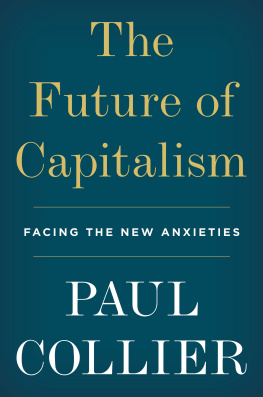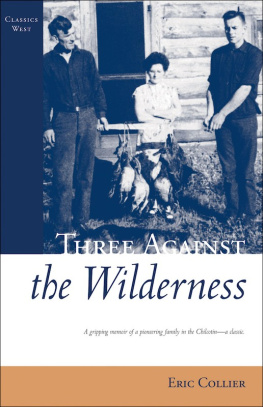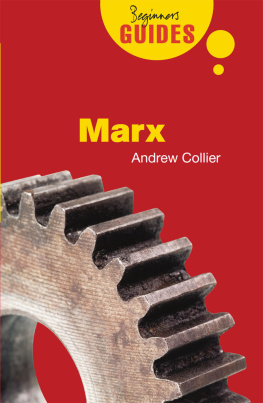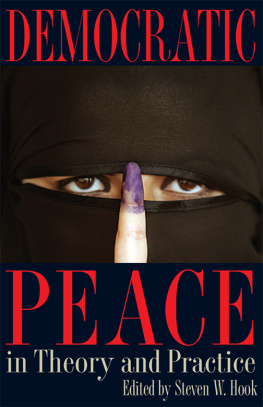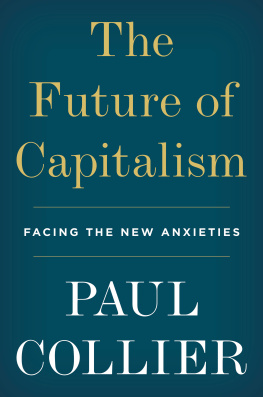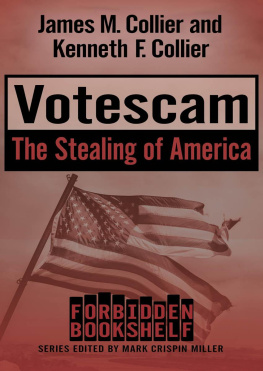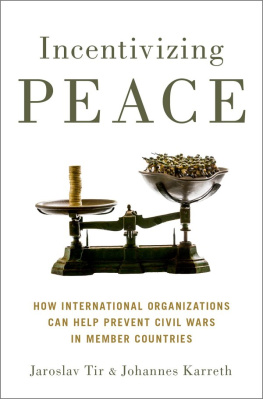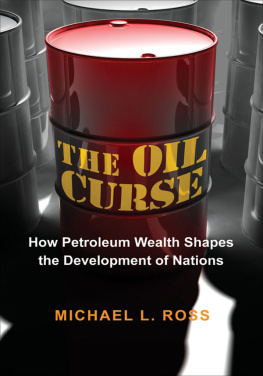Contents
Democracy in Dangerous Places
Denying Reality: Democrazy
Votes and Violence
Ethnic Politics
Inside the Cauldron: Post-Conflict Settlements
Facing Reality: Nasty, Brutish, and Long
Guns: Fueling the Fire
Wars: The Political Economy of Destruction
Coups: The Unguided Missile
Meltdown in Cote dIvoire
Changing Reality: Accountability and Security
State Building and Nation Building
Better Dead Than Fed?
On Changing Reality
The Bottom Billion
DEMOCRACY IN DANGEROUS PLACES
M Y SON D ANIEL, NOW AGE seven, may live to see the eradication of war. Or he might die in one. Why each of these is a realistic prospect for todays children is the subject of this book. War, like disease, has been endemic since the dawn of man. Diseases are now being conquered: in 1977 scientific advance and public action in combination eradicated smallpox. For the first time in history, the world economy looks capable of delivering the material conditions necessary for global peace. But global prosperity also increases the risks: an interconnected world is more vulnerable to any remaining pockets of chaotic violence. Just as the eradication of smallpox depended upon harnessing science through public action, so rising prosperity must be harnessed to secure the prize of global peace.
Wars, Guns, and Votes is about power. Why focus on power? Because in the impoverished little countries at the bottom of the world economy that are home to a billion people, the predominant route to power has been violence. Political violence is both a curse in itself and an obstacle to accountable and legitimate government. It is a curse because the process of violent struggle is hugely destructive. It is an obstacle because where power rests on violence, it invites an arrogant assumption that government is there to rule rather than to serve. You only have to look at the official photographs of political leaders to get the point. In the mature democracies our political leaders smile : they are desperate to ingratiate themselves with their masters, the voters. In the societies of the bottom billion the leaders do not smile: their official portraits stare down from every public building, every schoolroom, with a menacing grimace . They are the masters now that thankfully the colonialists have gone. Wars, Guns, and Votes investigates why political violence is endemic in the bottom billion and what can be done to curtail it.
Since the end of the Cold War two extraordinary changes have occurred, each of which may be opportunities for a decisive shift away from political violence. Both were consequences of the fall of the Soviet Union.
Elections spread across the bottom billion. The image of the popular uprisings in Eastern Europe inspired pressure for political change around the developing world. In the early 1990s national conventions sprang up around West Africa. By 1998 Nigeria, Africas largest society, sprang out of military dictatorship. Just as around the first millennium the leaders of Europes petty states had suddenly all converted to Christianity to get in step with the times, so around the second millennium the leaders of the petty states of the bottom billion all converted to elections. Prior to the end of the Cold War most leaders of the bottom billion had come to power through violence: success in armed struggle or a coup dtat. Now most are in power through winning elections. Elections are the institutional technology of democracy. They have the potential to make governments both more accountable and more legitimate. Elections should sound the death knell to political violence.
The other encouraging change is an outbreak of peace. For the thirty years prior to the end of the Cold War, violent conflicts were breaking out more rapidly than they were ending, so that there was a gradual proliferation of civil wars. Once started, civil war proved highly persistent: a civil war typically lasted more than ten times as long as an international war. But then, one after another of the ghastly and persistent civil wars came to an end. The war in Southern Sudan was closed by a peace settlement. The war in Burundi was similarly coaxed into a negotiated peace. The war in Sierra Leone was ended by international peacekeepers. The end of the Cold War unblocked the international community to exert itself against the continued struggle for power by means of violence.
The wave of peace settlements reinforced the wave of elections and promised a brave new world: an end to the pursuit of power through violence. How can we tell how these changes will play out? Can we do more than speculate? I think we can. Although the coincidence of these shocks is unprecedented, each can be analyzed based on how they have played out in the past. There have been previous experiences of electoral competition in the bottom billion. There have been many post-conflict situations. This book uses those experiences to analyze history in the making. As you read Wars, Guns, and Votes you may be struck by how fast the research frontier is moving. I get that sense morning by morning as I walk to work wondering whether, during the previous evening, Pedro, or Anke, or Dominic, or Lisa, or Benedikt, or Marguerite has cracked whatever problem we had crashed into by the time I left for home. I hope you get a sense of it too.
Political violence is one variant of the struggle for power. We now see it as illegitimate: might does not make right. In the high-income societies over the past century we have internalized the principles of democracy, and gradually we have come to regard them as universal. Ballots, not bullets, should pave the route to power. Since the end of the Cold War the high-income democracies have taken a further step: from merely regarding these standards as universal to actively promoting them. Despite the tensions over Iraq about whether active promotion should go all the way to enforced regime change or stop short at nonviolent encouragement and inducements, the international community is agreed on the goal. And it has largely succeeded: in the brief period of less than two decades democracy has spread across the low-income world. So what have been the consequences for peace?
The good news is that the world has been getting safer. In fact, despite the catastrophic period of the world wars, it has unsteadily but gradually been getting safer ever since humanity started. Contrary to all those images of the noble savage, early societies were murderous. There never was a peaceful Eden from which we have fallen: peace is something that has gradually been built, millennium by millennium, century by century, and decade by decade. The need for security from political violence has always been fundamental to human society. The great archaeological legacies of antiquity, such as the Great Wall of China and the massive barrier constructed across Jutland by the ancient Jutes against the Germanic tribes, stand as an enduring testimony to the overwhelming priority afforded to collective defense. This priority continued until very recently: for forty years the richest society on earth, America, devoted up to 9 percent of its national income to defense spending to meet the security threat from the Soviet Union.
With the collapse of the Soviet Union an era is over. Despite appearances, the last decade has been rather peaceful. The measure used in this grim academic niche is battle-related deaths . The Armed Conflict Data Set keeps a running tally both of the really large conflicts, those that cause at least a thousand such deaths during a year, and of the smaller ones that nevertheless caused more than twenty-five deaths. Here is what happened according to these measures.




